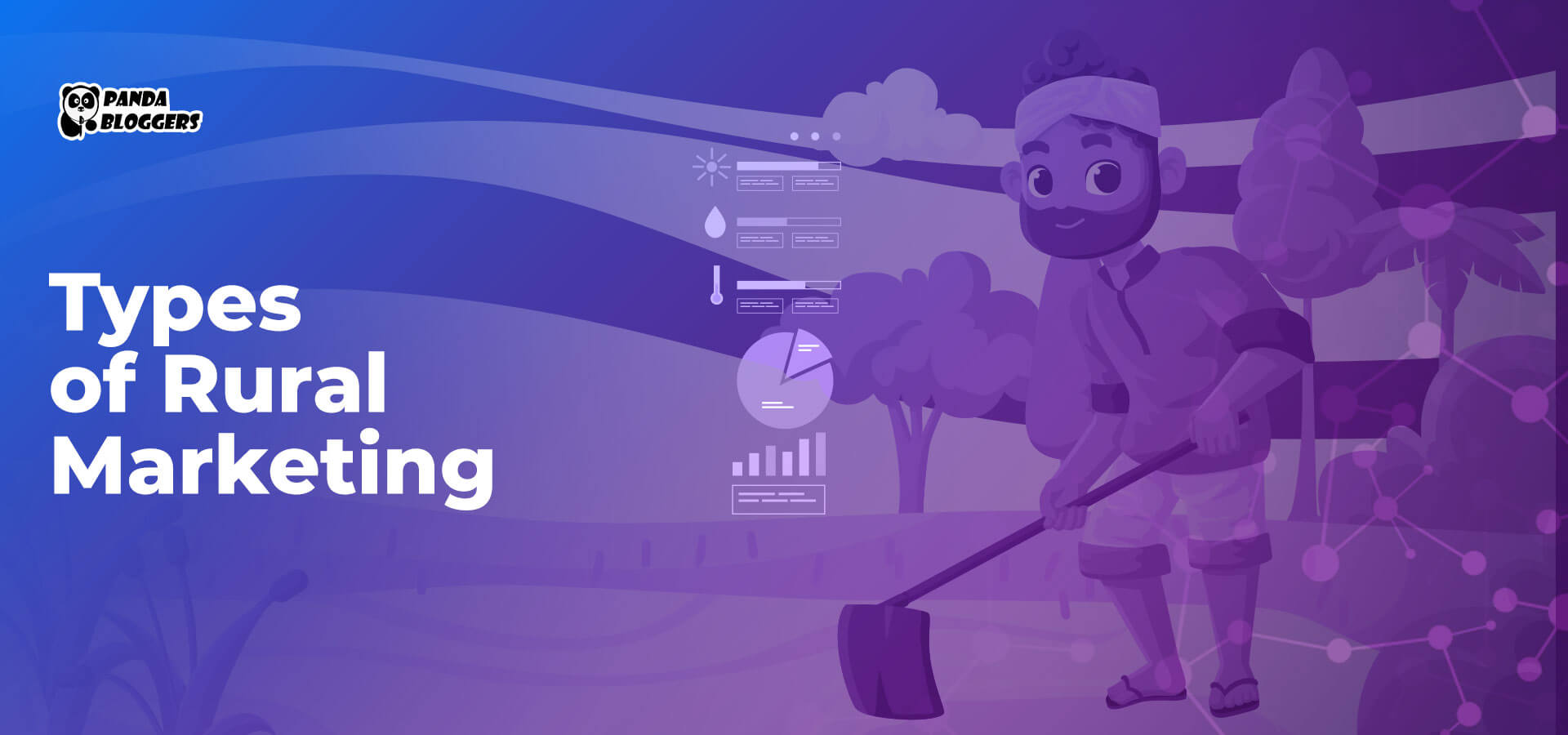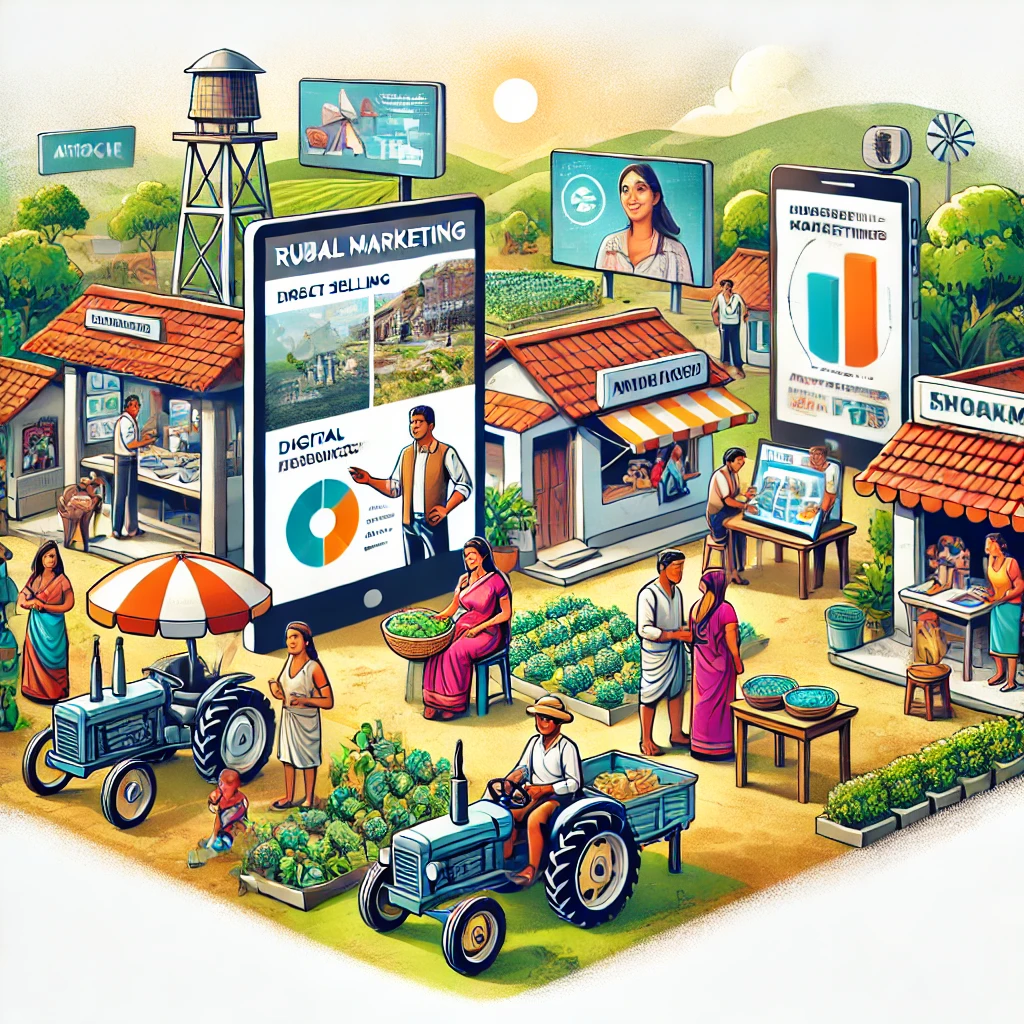 Types of Rural Marketing
Types of Rural Marketing
In many developing countries, the rural population is much higher than the urban population. For instance, 65% of Indians live in rural areas, while 35% of India’s population lives in cities and towns. Several researchers have highlighted a steady increase in the disposable income and purchasing power of people living in rural areas. Needless to say, Rural marketing in India has been gaining prominence. After the pandemic, 30% of 40% of smartphones sold in India were purchased by customers living in rural areas. The rural population and rural prosperity create opportunities for domestic and multinational companies to maximize revenue by making products and services available in rural markets. So, companies need to understand the types of rural marketing and create strategies for them accordingly.
Some of the prominent companies and startups have been adopting rural marketing in various forms and ways. First, they try to understand the difference between rural and urban marketing. Once they get hold of that, they try to capture rural market share by introducing rural-specific products. At the same time, many companies make the same product launch in urban and rural markets simultaneously.
Hence, the rural marketing strategies adopted by companies vary. Also, each company customized rural marketing strategies according to the needs, preferences, and expectations of targeted customers. We can discuss different types of rural marketing based on products offered and strategies implemented by various companies.
What Is Rural Marketing?
Rural marketing involves promoting and distributing goods and services in areas outside urban centers by understanding the unique socio-economic and cultural context of rural consumers. It requires tailoring products, pricing, communication, and distribution to factors like lower literacy rates, variable incomes tied to agricultural cycles, and strong community influences. Unlike urban marketing, rural marketing often leans on localized tactics—such as vernacular messaging, on-ground demonstrations, and leveraging local influencers—to build trust and relevance. With around 65% of India’s population in rural regions and rising disposable incomes, tapping this segment is crucial for sustained growth. Moreover, improving infrastructure and smartphone penetration are opening new digital avenues, but the core remains understanding and respecting rural mindsets.
Key Aspects of Rural Marketing
Several critical aspects distinguish rural marketing from its urban counterpart, starting with consumer behavior: rural buyers often rely on word-of-mouth, community leaders, and tangible demonstrations before purchase. Pricing sensitivity is paramount since incomes fluctuate seasonally; thus, flexible payment options or smaller pack sizes can be more effective. Distribution challenges due to poor roads and fragmented supply chains necessitate innovative last-mile solutions like mobile vans, local kiosks, or partnerships with micro-distributors. Communication must be highly localized—using regional languages, simple visuals, and oral storytelling—to address low literacy and diverse dialects. Finally, building trust and long-term relationships is key, as rural consumers value credibility and peer recommendations above flashy ads.
Classification of Rural Markets
The classification of rural markets helps marketers segment and tailor strategies effectively by grouping markets based on characteristics like product/service categories, distribution structure, and demographic/behavioral attributes. One approach classifies rural markets into consumer, industrial, and service markets: consumer markets cover households buying FMCGs or durables; industrial markets include agriculture-related enterprises buying inputs like seeds or machinery; and service markets encompass banking, healthcare, and education services. Another dimension is geographic and distribution-based classification: village markets, primary wholesale markets, secondary wholesale markets, terminal markets, and seaboard markets—each requiring different logistics and promotional tactics. Classification by market structure (primary vs. secondary rural markets) differentiates direct-to-consumer models from those relying on intermediaries. Using the classification of rural markets framework ensures strategies align with local realities, optimize resource allocation, and address specific consumer needs accurately.
Classification of Rural Marketing
An enterprise can adopt rural marketing in multiple ways. For instance, a company can develop rural-specific products and make them available in rural markets. Likewise, a company can promote and popularize its existing products in rural markets. Hence, we can look at the classification of rural marketing based on products and market structure.
Products/Services
Both rural and urban companies these days distribute and promote their products in rural markets. Some companies usually market crops, seeds, fertilizer, and similar agricultural products. Likewise, many companies provide irrigation tools and agricultural machines to rural customers.
At the same time, many companies these days generate revenue by selling non-agricultural products like vehicles, books, household appliances, and other consumer durables. Hence, rural marketing can be divided into two broad categories – agricultural and non-agricultural – based on products or services sold by companies.
Market Structure
While categorizing rural markets, companies often use the size of the customer base and the purchasing power of consumers as the primary parameters. However, rural marketing can be either primary or secondary according to the way products are distributed and sold by companies.
In a primary rural market, companies distribute and sell products directly to consumers. Also, many companies these days deliver products to rural customers using e-commerce platforms. However, businesses redistribute products in secondary rural markets using intermediaries like dealers, retailers, and agents.
Marketing Mix
Marketing mix can be described as the strategies and tools companies use for promoting and selling products in targeted markets. The rural marketing mix consists of four important components – product, price, promotion, and placement. Product refers to the goods or services offered by a company.
Price refers to the cost incurred by consumers to avail of the product or service. Promotion refers to the promotional and advertising activities required to create awareness, generate demand, and boost sales, while placement refers to the distribution channels used by a company to make its products available in rural markets.
Types of Rural Marketing
Companies these days promote and market products in rural areas through multiple channels. Increasing smartphone penetration creates opportunities for them to engage and influence rural consumers by running social media marketing, email marketing, and mobile marketing campaigns.
However, a significant percentage of companies still promote their products using conventional advertising tactics like mobile van marketing, retailer marketing, and billboard advertising. Hence, rural marketing can be divided into several categories according to promotional strategies used by companies.
Direct Marketing
A low literacy rate is one of the major challenges of rural marketing. Companies run direct marketing campaigns to inform rural consumers about products or services in simple and local languages. They deploy marketing executives who create product awareness and generate demand by educating rural consumers. Also, many companies facilitate direct selling by setting up kiosks in selected rural areas.
Key Example: Hindustan Unilever runs direct marketing campaigns under its Project Shakti, empowering rural women by training them to become direct-to-consumer sales agents. These women, known as Shakti Ammas, visit homes in their villages to sell products like soaps, detergents, and personal care items. They communicate in local languages and tailor messages to resonate with the community, successfully bridging the literacy gap.
Agricultural Marketing
This type of rural marketing focuses on marketing agricultural inputs like seeds, fertilizers, and machinery, as well as outputs like grains and produce. It involves creating networks between farmers, wholesalers, and retailers.
Key Example: The National Agricultural Market (eNAM) is a revolutionary initiative by the Government of India aimed at creating a unified national market for agricultural commodities. Launched in April 2016, eNAM is an online trading platform that integrates physical mandis (agricultural markets) across the country. It streamlines the buying and selling of produce by eliminating intermediaries and ensuring transparency in price discovery.
Periodic Marketing
Local marketplaces are an integral part of most rural marketplaces. Local people purchase products by visiting the traditional marketplace held on a specific day every week. The gathering of local consumers creates opportunities for companies to capture market share by displaying and promoting various products to a large number of rural customers.
Key Example: Weekly Haats in Rural India: In states like Jharkhand, Odisha, and Madhya Pradesh, haats are common gathering places where farmers, artisans, and small-scale traders sell agricultural produce, handicrafts, household items, and everyday goods. For instance, the Santhal Parganas haats in Jharkhand attract local producers and consumers, creating an excellent opportunity for companies to reach a large audience in a single location.
Retail Marketing
Many consumers find it challenging to promote their products directly in rural markets. They save time and resources by partnering with local retailers and store owners. The retailer helps companies promote products by interacting with local customers. At the same time, they facilitate the distribution and promotion of products on a regular basis.
Key Example: ITC’s e-Choupal Integration: ITC leverages its vast rural network through e-Choupal to promote and sell its FMCG products. While e-Choupal primarily focuses on agricultural procurement, it also serves as a channel for ITC’s packaged food products, stationery, and personal care items, distributed through local rural retailers.
Mobile Van Marketing
This form of rural marketing helps companies overcome key challenges like poor and limited infrastructural facilities. The marketing professional driving the van promotes and sells products in rural markets. Also, they generate demand and promote customer loyalty by answering questions asked by consumers.
Key Example: Coca-Cola leveraged mobile vans to reach rural markets by organizing interactive campaigns. The vans offered free product tastings, distributed branded merchandise, and engaged communities with games and entertainment activities. These campaigns helped Coca-Cola build brand recall in areas where traditional advertising channels were scarce.
Durable Goods Marketing
This type targets rural buyers for items like bicycles, mobile phones, and home appliances. With increasing incomes and government schemes like Saubhagya Yojana (rural electrification), the demand for durable goods is on the rise.
Key Example: Hero MotoCorp has solidified its position as a leader in the rural Indian market through a well-thought-out strategy catering to the specific needs of rural consumers. The company’s focus on affordable, fuel-efficient motorcycles has been a key driver of its success. Models like the Hero Splendor and HF Deluxe have been particularly popular in rural areas due to their reliability, low maintenance costs, and high fuel efficiency, which are crucial factors for rural buyers where road infrastructure and fuel accessibility might be limited. Hero MotoCorp also leverages its extensive dealership and service network, reaching even remote areas. Moreover, the company’s financing options through tie-ups with microfinance institutions and rural banks make it easier for rural consumers to purchase two-wheelers.
Traditional Display Marketing
While planning urban marketing campaigns, marketers prioritize digital display ads over conventional display ads. However, they still use wall paintings, posters, and billboards while promoting products in rural areas. Traditional display strategies help companies create brand awareness and attract potential customers.
Key Example: Billboards in Market Areas: Mahindra & Mahindra employs billboards to market its tractors and agricultural equipment in rural areas. These billboards are placed near mandi (market) areas or along major highways where rural consumers gather, ensuring maximum visibility.
Service Marketing
Rural areas are increasingly becoming a target for services like banking, healthcare, and education. Financial inclusion through schemes like Pradhan Mantri Jan Dhan Yojana has brought banking services closer to rural households.
Key Example: Microfinance institutions (MFIs) and rural banking kiosks have been instrumental in bridging the financial inclusion gap in India’s rural areas. These services are designed to bring essential banking and financial tools closer to underserved communities, empowering them economically. MFIs like Bandhan Bank and Ujjivan Small Finance Bank have provided micro-loans to rural households, especially women entrepreneurs, enabling them to start small businesses and achieve financial independence. These institutions cater to the unique needs of rural populations by offering flexible repayment terms and low interest rates, which are crucial for communities with limited financial literacy.
Mobile Marketing
A surge is being noted in the number of rural families owning smartphones. A significant percentage of rural people still use feature phones. Mobile device penetration creates opportunities for businesses to run mobile marketing campaigns. Many companies create brand awareness and generate demand in rural markets by sending text messages to consumers.
Key Example: HUL’s Kan Khajura Tesan: Hindustan Unilever Limited (HUL) implemented a mobile marketing campaign called Kan Khajura Tesan to reach rural audiences without television access. The initiative provided free, engaging audio content like jokes, songs, and advertisements for HUL products through a missed call service. This campaign allowed HUL to create brand awareness and engage with millions of rural users via feature phones.
Digital and E-Commerce Marketing
With increased smartphone penetration and affordable internet access through initiatives like Digital India, rural e-commerce is booming. Platforms such as Amazon and Flipkart now have dedicated strategies for rural consumers.
Key Example: A key driver of this transformation is the adoption of digital payment systems, primarily through UPI (Unified Payments Interface) apps such as PhonePe, Paytm, and Google Pay. These apps simplify transactions and reduce the dependency on physical cash, which has been a barrier in remote areas. For instance, in collaboration with small businesses in rural areas, PhonePe has facilitated digital payments at local grocery stores, agricultural markets, and retail shops, encouraging faster adoption of cashless systems.
Cooperative Marketing
This involves marketing through cooperatives owned by rural producers. These cooperatives facilitate collective bargaining, ensuring better prices for rural producers.
Key Example: AMUL (Anand Milk Union Limited) is one of the most iconic examples of cooperative marketing in the world. Founded in 1946 in Gujarat, India, AMUL was established to counter the exploitation of rural dairy farmers by middlemen and to empower them with fair prices for their produce. This initiative has a direct impact on over 3.6 million milk producers in Gujarat alone and a contribution to India’s rise as a leading player in the global dairy market.
Event and Haats-Based Marketing
In rural India, weekly markets (haats) and fairs (melas) are focal points for commerce and social interaction. Businesses use these platforms to introduce and sell their products.
Key Example: Consumer brands frequently organize product demonstrations and promotions at rural fairs.
Direct-to-Village Marketing
In this type, companies bypass traditional distribution channels and directly connect with rural consumers. This approach helps build trust and reduces costs.
Key Example: ITC’s e-Choupal is a pioneering direct-to-village marketing initiative that empowers rural farmers by providing them with direct access to markets, real-time information, and agricultural expertise. Farmers can use these digital kiosks, set up in villages, to check crop prices, weather forecasts, and best farming practices. By eliminating intermediaries, e-Choupal enhances farmers’ earnings and reduces inefficiencies in the supply chain. This initiative has not only improved rural livelihoods but also strengthened ITC’s engagement with rural communities, creating a win-win for both farmers and the company.
Seasonal and Festival Marketing
Rural India thrives on agricultural seasons and festivals, which significantly influence purchasing behavior. Brands align their marketing efforts with these key occasions.
Key Example: In rural India, agricultural cycles and festivals play a pivotal role in shaping consumer behavior, making them ideal opportunities for targeted marketing. Agricultural equipment manufacturers, for instance, intensify promotions and discounts during the sowing season when farmers invest in tools and machinery to prepare their fields. Similarly, FMCG brands capitalize on festivals like Diwali in the North and Pongal in the South by offering special packaging, festive discounts, and culturally resonant campaigns to drive sales. These strategies not only boost brand visibility but also align with the emotional and financial readiness of rural consumers during these periods.
Rural Marketing Examples: Let’s Look at Some More Interesting Examples
Rural marketing strategies have been successfully implemented by several brands across different industries. Here are some notable rural marketing examples of how companies have effectively engaged consumers:
Coca-Cola’s Parivartan Program
Coca-Cola India introduced the Parivartan Program to train rural retailers on best business practices, product placement, and customer service. This helped strengthen relationships with local shop owners while ensuring better brand visibility in rural markets.
Hindustan Unilever’s Project Shakti
Hindustan Unilever Limited (HUL) initiated Project Shakti to enhance its rural distribution network by empowering women in villages. The company trains women entrepreneurs, known as “Shakti Ammas,” to sell HUL products directly within their communities, thereby increasing product reach and providing livelihood opportunities. This initiative has significantly expanded HUL’s presence in rural India.
Hyundai’s “Experience Hyundai” Campaign
Hyundai Motor India launched the “Experience Hyundai” campaign across 418 rural areas to engage potential customers. The campaign involved caravans showcasing Hyundai vehicles, allowing rural consumers to experience the cars firsthand. This approach aimed to build brand awareness and trust among rural audiences.
HDFC Bank’s ‘Har Gaon Hamara’ Initiative
HDFC Bank launched the ‘Har Gaon Hamara’ initiative to extend banking services to unbanked rural areas. The program includes financial literacy campaigns and the establishment of banking correspondents, making banking more accessible to rural populations.
Nokia’s “Made for India” Rural Campaign
Nokia targeted rural consumers by launching durable and affordable mobile phones with long battery life and built-in torches, catering to areas with inconsistent electricity supply. Their localized advertising campaigns in regional languages helped boost adoption in rural markets.
Patanjali’s Ayurveda-Based Rural Expansion
Patanjali leveraged traditional Ayurveda to penetrate rural markets by promoting affordable, natural health and wellness products. Their strong distribution network, combined with Baba Ramdev’s influence, made them a preferred choice in rural households.
Colgate Palmolive’s Rural Expansion
Colgate Palmolive (India) reported a significant increase in profit, driven by expansion into rural markets and strong demand for its personal care products. The company’s promotion of oral health programs has further boosted rural demand, with rural sales outpacing urban sales for consecutive quarters.
Mahindra’s Samriddhi Centers
Mahindra & Mahindra set up Samriddhi Centers across rural India, providing farmers with expert advice, soil testing, and better farming techniques. This initiative strengthened Mahindra’s brand in the agriculture sector and built long-term relationships with rural consumers.
Amul’s Rural Dairy Model
Amul’s cooperative dairy model successfully connected rural farmers to urban consumers, ensuring fair pricing for dairy producers. Their effective supply chain and marketing campaigns like “Amul Doodh Peeta Hai India” helped build a strong brand presence.
These rural marketing examples highlight how businesses can adapt their strategies to rural markets, ensuring growth while creating value for local communities. Implementing localized marketing, leveraging digital platforms, and addressing rural consumer needs can lead to long-term success in rural marketing.

Challenges and Opportunities in Rural Marketing
Challenges
Rural marketing in India is fraught with challenges that stem from underdeveloped infrastructure and logistical barriers. Poor road connectivity and limited transport facilities hinder the efficient distribution of goods and services to remote areas. Furthermore, low literacy rates in many rural regions pose a significant hurdle, as they limit the ability of consumers to engage with traditional marketing materials like written advertisements or product manuals. Another critical challenge is the limited reach of conventional media like television and newspapers in isolated villages, which restricts the scope of mass communication campaigns. These factors collectively make rural marketing a complex and resource-intensive endeavor, requiring innovative and tailored approaches.
Here is a detailed post on challenges in rural marketing.
Opportunities
Despite these challenges, rural India represents a goldmine of opportunities for businesses willing to invest strategically. Rising income levels, driven by government programs like rural employment schemes and agricultural subsidies, have increased purchasing power in villages. Additionally, initiatives under the Digital India program have accelerated internet penetration and smartphone adoption, making digital platforms an effective medium for reaching rural consumers. Companies can also leverage government-sponsored schemes and financial inclusion programs to develop trust and familiarity within these communities. With the right strategies, businesses can tap into the vast, untapped potential of rural markets, fostering economic growth and building lasting consumer relationships.
Conclusion
The number and prosperity of people living in rural areas make rural marketing the next destination for companies and startups. But the purchasing power of rural consumers varies across regions. Also, the purchase decisions of rural customers are often impacted by local customers and beliefs.
Hence, companies must understand different types of rural marketing to decide the best way to enter a rural market and capture market share. In addition to classifying and categorizing rural marketing activities, they need to choose and combine the right rural marketing strategies.
We refreshed this blog post in February 2025 to make it more suitable for our readers.










Leave a Reply